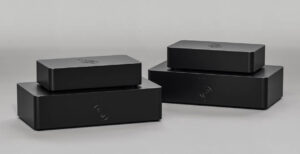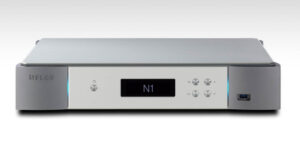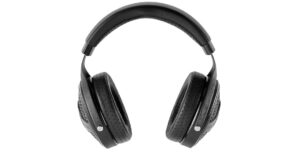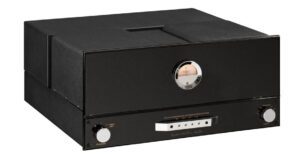
We can dance around this, but the Sonus faber Olympica II represents the right answer to an increasingly important question in audio: Can we have style AND substance? The usual answer is to dismiss anything that looks good with a wave of the hand, mumbling something about ‘style over substance’ in the process. The Olympica range makes a strong case for the importance of both.
Let’s face it. In the past, it might have been possible for audio enthusiasts to force their hand and install hideous looking loudspeakers in the living room, but we are living in the 21st Century now, and that insistence seems like something from a bygone age. We live in smaller, more design-led homes, and the notion of a pair of big, angular, and often ugly coffins in an otherwise elegant lounge is increasingly unthinkable. However, tastes vary significantly from country to country, and it’s hard to get this kind of elegance ‘right’ on a truly international level.
Unless the company is Sonus faber. Because Sonus faber seems to make pieces of musical furniture with the sort of timeless, trans-national elegance of a chair designed by Charles and Ray Eames, Arne Jacobsen, or Mies van der Rohe. In most cases, this would be hyperbole on a grand scale. Except that it isn’t; Sonus faber in general and the Olympica range in particular is an exercise in sublime product design, and that now comes down to Livio Cucuzza, Chief Industrial Designer for Fine Sounds Group.
The Olympica II is Sonus faber’s entry floorstander in its Italian made ranges; the Venere models are built in the East to a high standard and sound great, but that outstanding reputation for making gorgeous pieces of fine wood, leather, and chrome comes from – and remains with – its factory amid the Palladian villas of Vicenza, Italy. And it’s that fine wood, leather, and chrome that draws you into these loudspeakers.

I can’t overstate this enough. Loudspeakers share your living space with you. They need to be as elegant as the furniture you choose to put in that living space. We reviewers tend not to pay too much attention to this key aspect of product design, because – by and large – we’re slobs. Put me in a suit and I look like a potato at a funeral, and my interior design skills more than match my sartorial elegance. Also, the wives of reviewers have to learn to love cardboard boxes, for they frequently fill up rooms, and they often complain it’s like living with a hoarder. But, if we put ourselves in the shoes of real people for a moment, not everyone shares our same lack of pride in domestic life, and some would like their neat, stylish home not to be undermined. The Olympica II goes a long way in meeting the needs of the elegant.
The leather topped and leather fronted design, with the Sonus faber name stamped into the black hide, starts the process. The subtle chrome ring around this leather-bound top follows suit, the panelled wood finish (reminiscent of that other great Italian classic, the Riva Aquarama runabout) and the elegant black spaghetti grill adds to the appeal, and the top to bottom side-venting chrome plate tops it off. The fact the Olympica II uses two different sizes of spike (which look more like armour-piecing shells than normal speaker spikes) allowing a gentle back tilt makes the loudspeaker a truly desirable floorstanding design, one that is just as likely to make it to the pages of an interior design magazine as a hi-fi magazine.

The problem with all this description of the loudspeaker art and design is that it’s the hi-fi equivalent of saying someone has “lovely hair”; it is meaningless unless the design is backed up with solid audio credentials. And that’s where Sonos faber succeeds where smaller brands cannot; the engineering team is separate from the design team, and is headed up by R&D supremo Paulo Tezzon.
Sitting in an office room in a corner of a house under the Heathrow flightpath on a cold and wet October day, it’s hard for a pudgy fiftysomething not to suffer a little bit of the ol’ green eye when it comes to this dynamic duo of Livio and Paulo. They are the next generation of designers; young, passionate, well-dressed, good-looking, and they work in a glorious part of the world. They turn out world-class products praised equally for industrial design and audio quality, while I knock out thousands of words that at best are mildly entertaining for a few minutes. Where did it all go so right for them?
Tezzon’s team created a three-way loudspeaker with what is called a “paralaminar stealth flow” port (the side-firing chamber running the length of the cabinet and covered by the elegant perforated chromed aluminium bar). The lyre-shape of the cabinet is deliberately irregular, and the shape is more complex than most teardrop or rectilinear boxes; this not only aids the construction of that paralaminar port, but reduces internal standing waves. And it looks good! It’s also made well; the front baffle is pressed ply instead of MDF, and the top and bottom of the cabinet is made from solid walnut, not laminate. This makes it exceptionally rigid. The back tilt allows a small, but handy, amount of time-alignment. The loudspeaker is biwireable, using Sonus faber’s own speaker terminals (if you are nerdy about such things, even these look cooler than most).
The loudspeaker uses Sonus faber’s custom-specified ‘arrow point’ 29mm silk tweeter, with the clever Damped Apex Dome design that makes it a combination dome and ring-radiator design. This is partnered to a 150mm midrange unit, which sports an organic composite cone material and a sharply tapered aluminium phase plug, and a 180mm cellulose/synthetic foam sandwich design with a dust cap. This driver choice is common to the Olympica II and III, with the larger loudspeaker adding a second bass unit, and a lot more mass.
Technologically, then, the Olympica II is a good design, but – paralaminar port aside – it’s not exactly breaking new ground in loudspeaker technology. When you listen to the loudspeaker, you realise it doesn’t need to be that ground-breaking, because it sounds so fine. This exemplifies the concept of the whole being better than the sum of the parts, and these are very, very good parts! Best of all, they are parts that sound good while not placing a great demand on the partnering electronics; it’s a comfortable 88dB sensitive, four ohm load, and one that doesn’t have too many scary phase angles and low impedance swings to punish the weak. You could happily put the Olympica II with a decent valve power amp of perhaps 60W or so and make a lovely sound.
The two words I’d used to sum up the Olympica II are ‘effortless’ and ‘mature’. Some loudspeakers always sound as if they are in a low gear. Nothing is a struggle, nothing is a challenge, but also nothing stirs the passions. What these speakers try – and fail – to do is what the Olympica II does so well: namely, manage to choose the right gear for the music. Not much troubles the Olympica II presentation, but it remains free from that listless, dispassionate sound that some mistake for effortlessness. How this comes across in the music is a natural sense of scale to sounds, moving easily from small folk sounds from Laura Marling [Once I Was An Eagle, Virgin], to the expansiveness of Domingo singing and Giulini conducting the LA Phil playing ‘Una Furtiva Lagrima’, from Donizetti’s L’elisir d’amore [Opern Gala, DG]. This isn’t even an extreme example, as the Olympica II perfectly portrayed the sound-scape of a recording regardless of size and scale.

Then there’s that ‘mature’ balance. This is a harder thing to describe, but best typified by the bass of the system, which is at once deep yet not ostentatious. Normally, loudspeakers that dig deep call out for heavy bass notes, in some kind of atavistic need in the listener. That holds whether you are reaching for the Mingus CD, the King Tubby LP, or the Bach Organ Works album. But the Olympica II helps you rise above this base bass desire. Sounds are full and very solidly placed in the wide soundstage the Olympica IIs produce, suggesting a deep foundation of low end, especially in averaged sized rooms. But there’s no sense of needing to push this bass to test it; the Olympica II is more grown up than that, and it drags you along with it. You end up playing music because you like to listen to music, not to score points off your audiophile self. Legao, by Erlend Øye [Bubbles Records, CD] is a perfect example of this; it’s an impressively recorded piece of not-quite-ironic soft-white-reggae-rock, that middle aged rockers in the 1970s seemed obsessed by. A track or two is usually enough, as it isn’t a concept album requiring a front-to-back listen. Except, on the Olympica II, I couldn’t help listening to the whole album at a single sitting. That whole ‘Classic Albums Sundays’ idea of respecting the record and playing it as a whole is almost mandatory here, because you find yourself so enjoying the music, there’s no need to move.
That’s the thing about the Olympica II; that effortless maturity is the audio equivalent of sitting back with a gin and tonic in hand after a long day. It’s so intrinsically right and enjoyable, it just de-stresses you in a way few other things can. It’s not a chill-out zone, and it’s not a ‘pull every piece of music out to see how it sounds’ speaker. It’s a refined dinner guest, a charming bon viveur with whom you want to spend some time. And, while it does the absolute detail and pin-precise dynamics very well, the Olympica II doesn’t stress these things. It’s an enthusiast’s speaker, but an enthusiast in the ‘passion’ sense, rather than the kind of guy who throws ‘π’ into polite conversation.
OK, so this isn’t a ‘raise the roof’ loudspeaker. It’s not designed for those wanting full-throat symphonic bombast, or pin-you-to-the-wall death metal played at concert levels. It will do surprisingly well at the whole thrash thing; I played ‘Yes! I Am A Long Way From Home’ and ‘Tracy’ by Mogwai [Mogwai Young Team, Chemikal Underground] and the Olympica II ran the full gamut from quiet start, through slow build, to full wig-out noise-maker brilliance. But it did put a limit on just how loud you could play the final moments (in fairness, few audio systems can play at the kind of nose-bleed intensity required to play Mogwai at full roar; it’s like being hit really slowly with a really large hammer, but in a good way). This fits the 99% rule; for 99% of listeners, 99% of the time, the Olympica II goes plenty loud enough, but it’s not the kind of garish impressive noise monster that pushes people to play at party levels for bragging rights.
There has been a little airbrushing of Sonus faber history since the company joined the Fine Sounds group. The founder of Sonus faber, Franco Serblin (1939-2013), was the driving force behind this concept of style and substance at a time long before ‘mission statements’ and corporate identities, but his name has all but fallen away from the brand he created (you won’t find it anywhere on the website, for example). However, despite this, I’d like to think he would approve of the Olympica II. It may not have been his pen on the drawing board, but it’s the sort of loudspeaker he would have designed.
But, I don’t want to leave this on a maudlin note. That’s not what this loudspeaker is all about. I think the Olympica range is in Sonus faber’s sweet spot; sandwiched between the value Venere range and the upmarket Homage and beyond, Olympica holds to the core values of good design and great sound that have always set Sonus faber apart from the crowd. And the Olympica II is in the middle of that sweet spot. In fairness, I’ve not tested the Olympica III and reports from the front suggest it’s even better than its little brother, but if it is, it’s got to be pretty damn fantastic, because the Olympica II comes very highly recommended in its own right. Style and substance… you bet!
Technical Specifications
- Type: Three-way, ported standmount loudspeaker
- Drive unit complement: 1x 29XTR2 Damped Apex Dome 29mm silk tweeter, 1x MW15XTR paper/kapok/kenaf 150mm composite midrange cone, 1x W18XTR 180mm cellulose/foam sandwich bass driver
- Frequency response: 40Hz-30kHz
- Sensitivity: 88dB SPL (2.83V/1m)
- Nominal Impedance: 4Ω
- Amplifier power handling: 50-250W
- Finish: lacquered natural walnut or graphite
- Dimensions (HxWxD): 105.5x37x47.2cm
- Weight: 34kg each
- Price: £6,998 per pair
Manufacturer: Sonus faber
URL: www.sonusfaber.com
UK Distributor: Absolute Sounds
Tel: +44(0)20 8971 3909
Tags: FEATURED
By Alan Sircom
More articles from this authorRead Next From Review
See all
Reiki Audio SuperSwitch Master Pro + Servant Pro
- Mar 27, 2024

Melco Audio N1-S38 music server
- Mar 27, 2024

Focal Utopia 2022 headphones
- Mar 27, 2024











